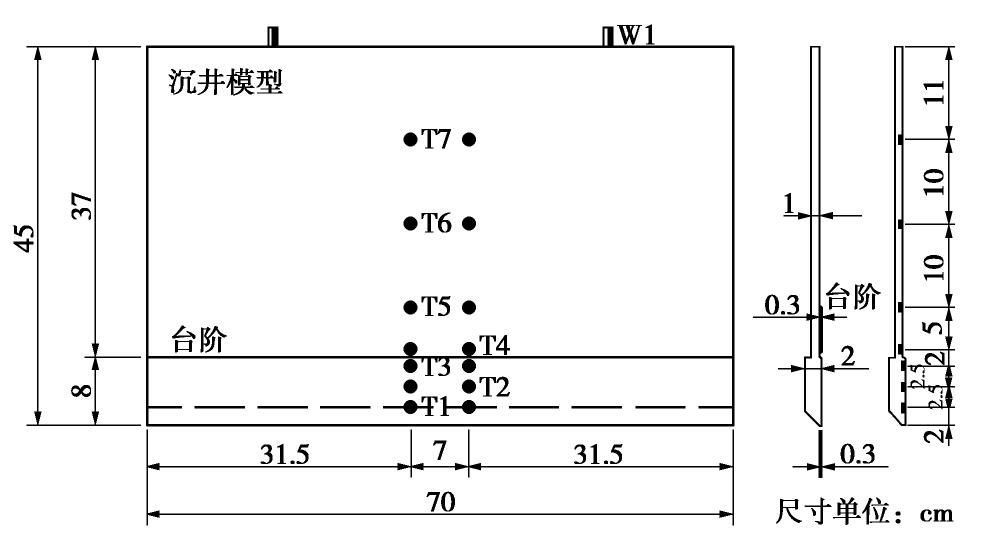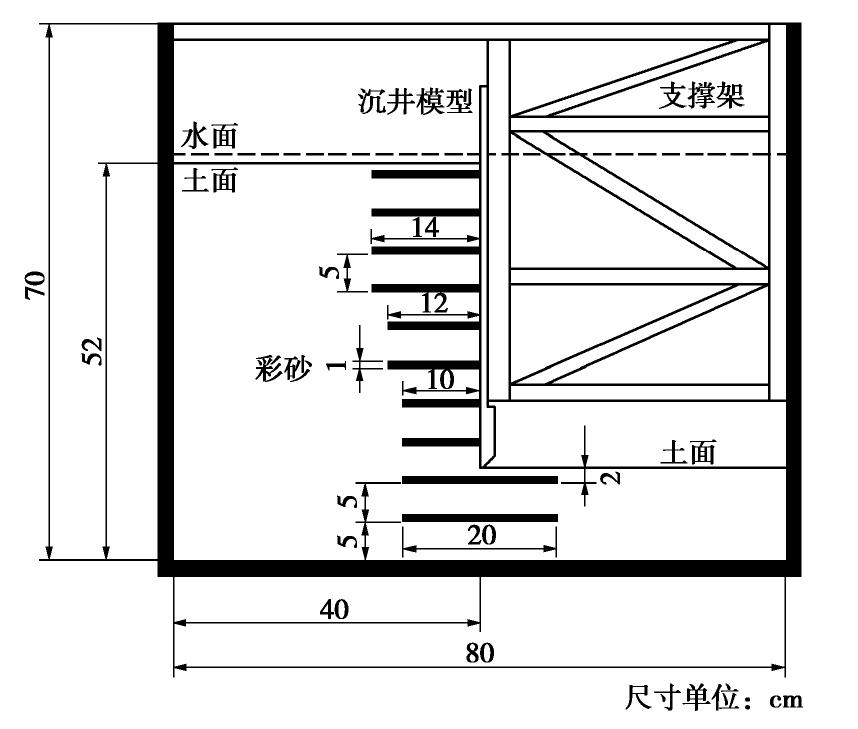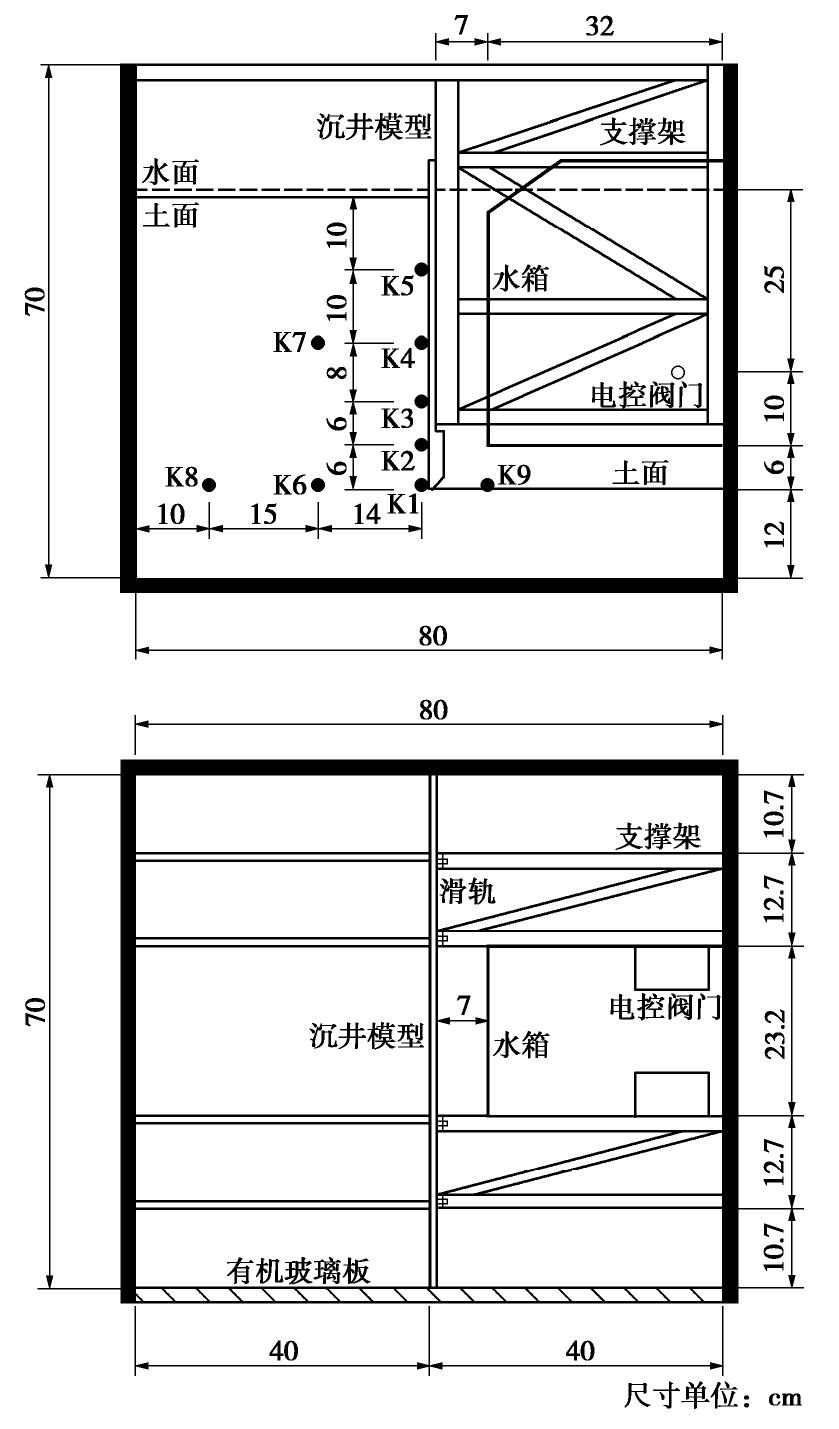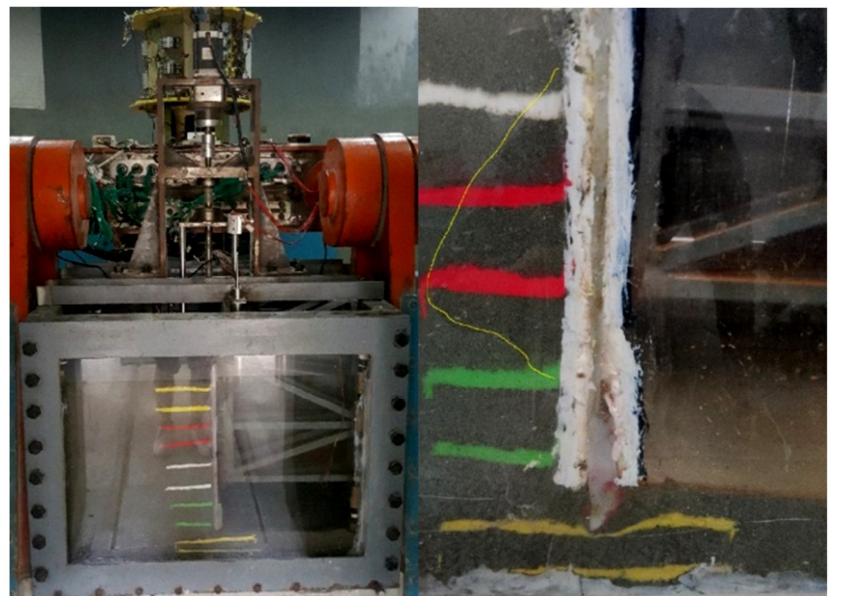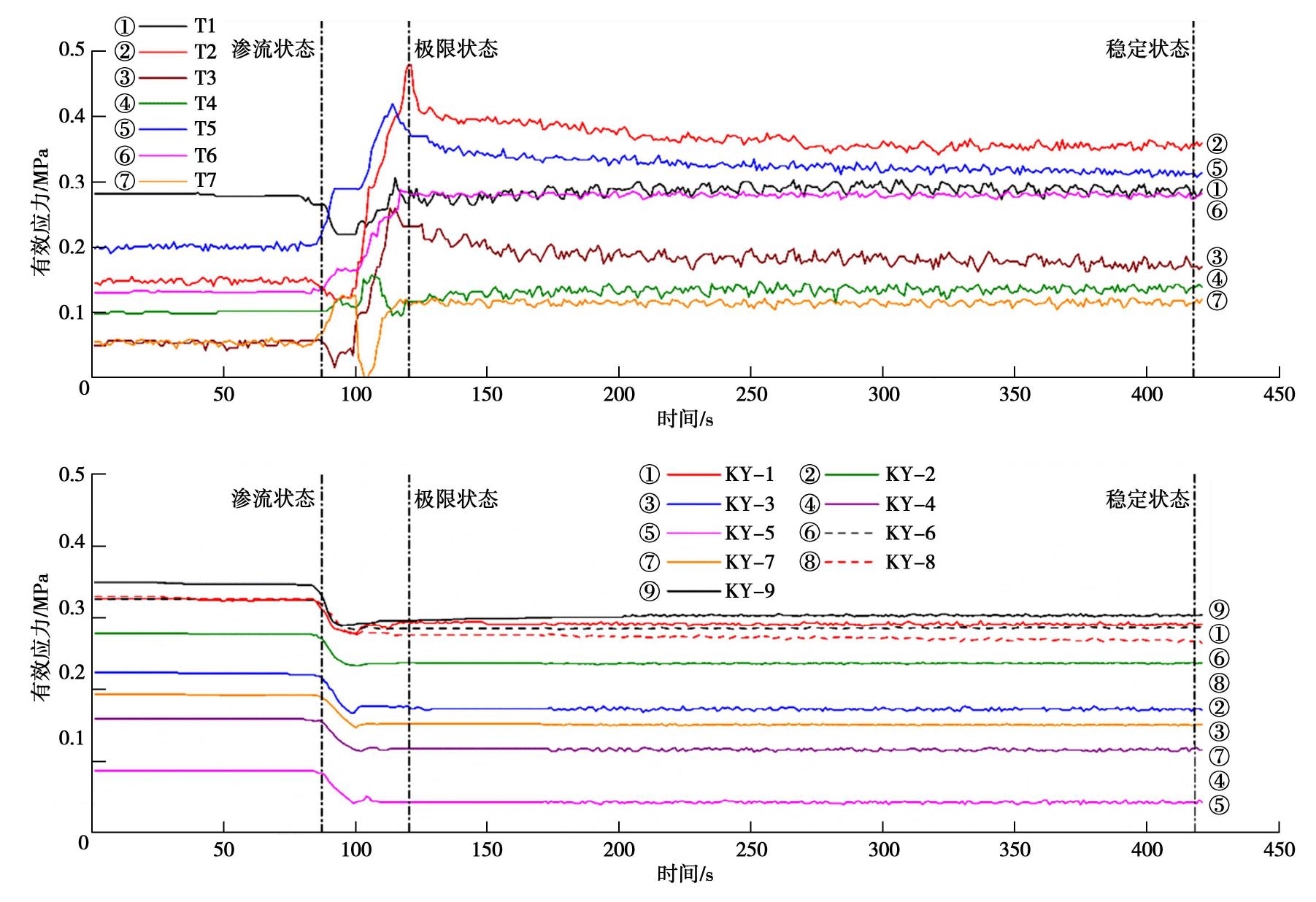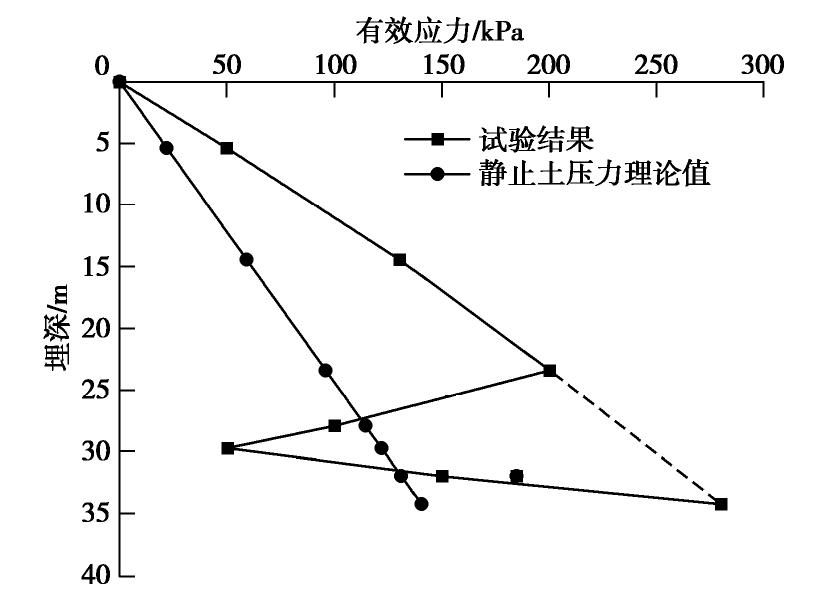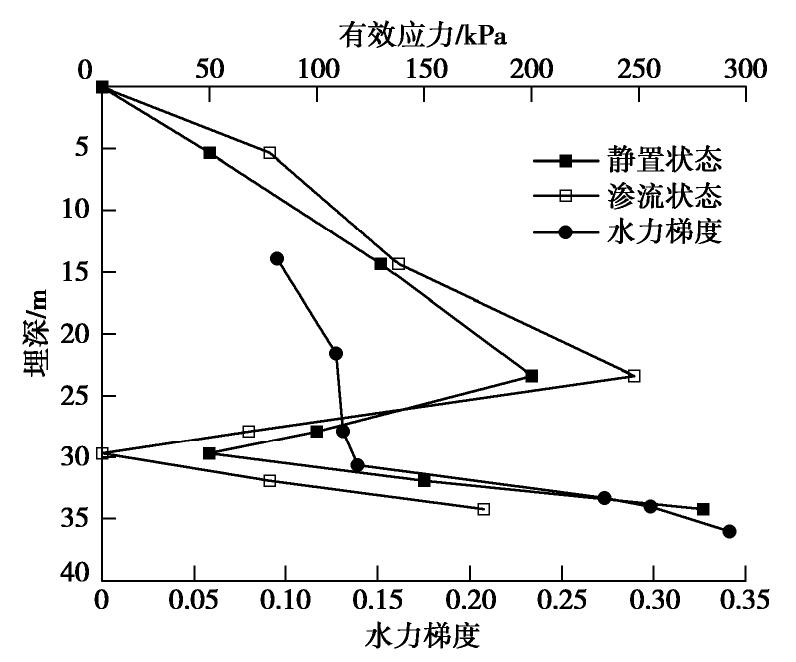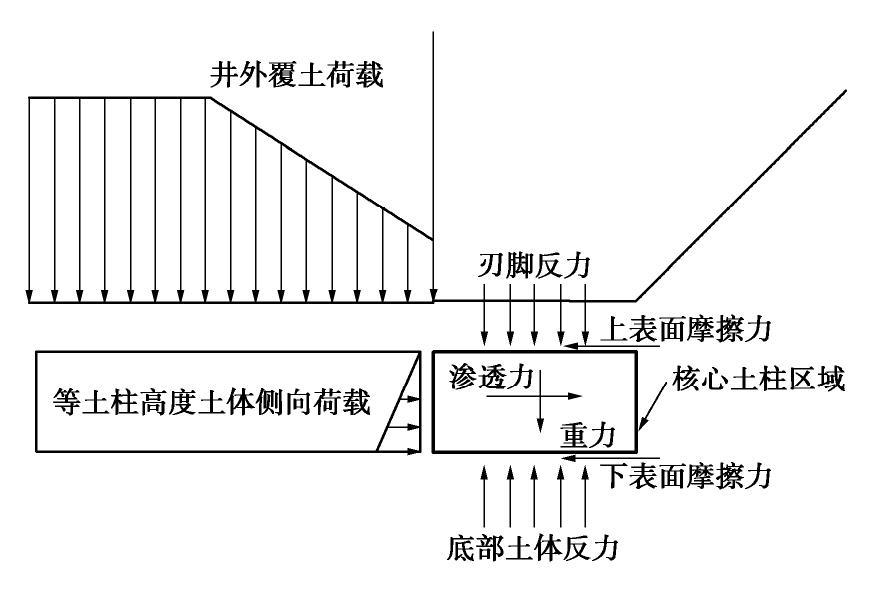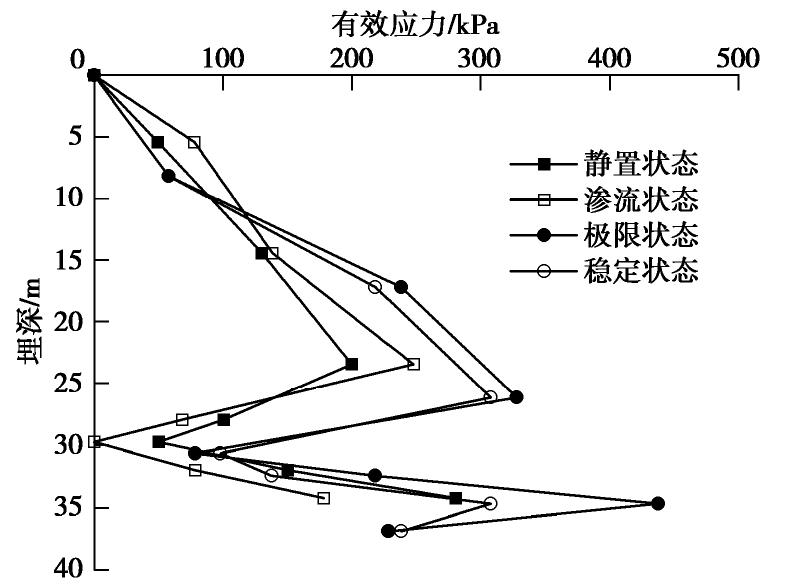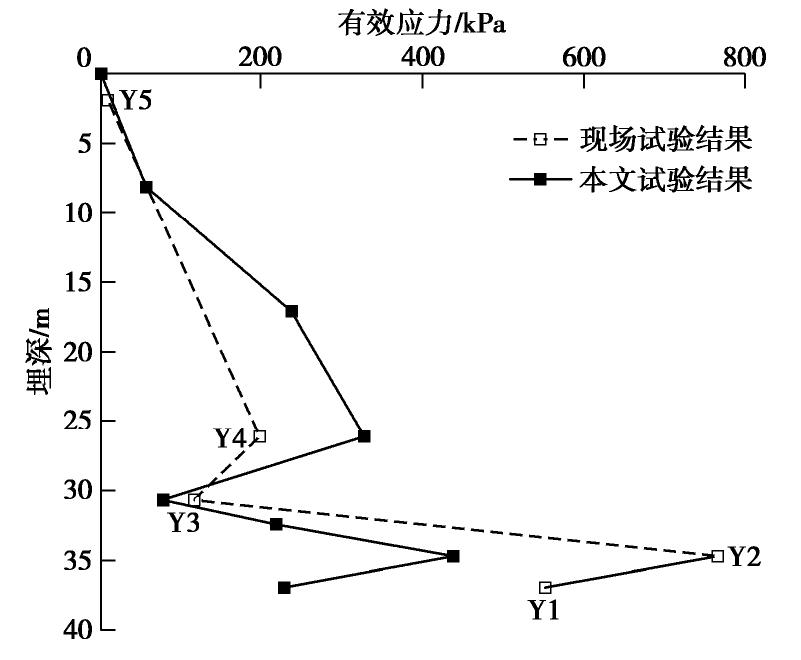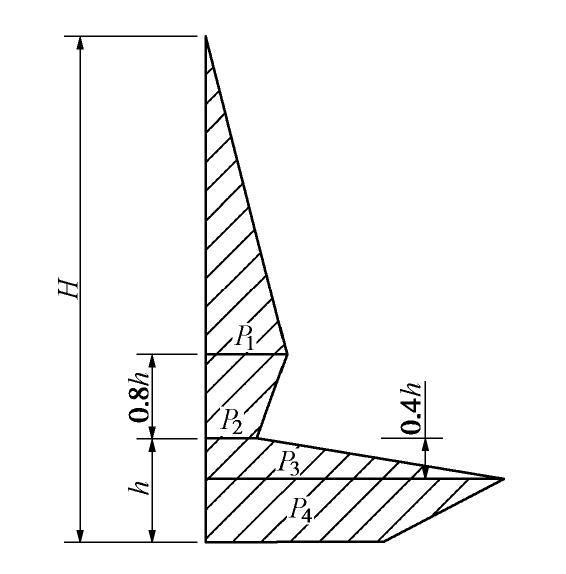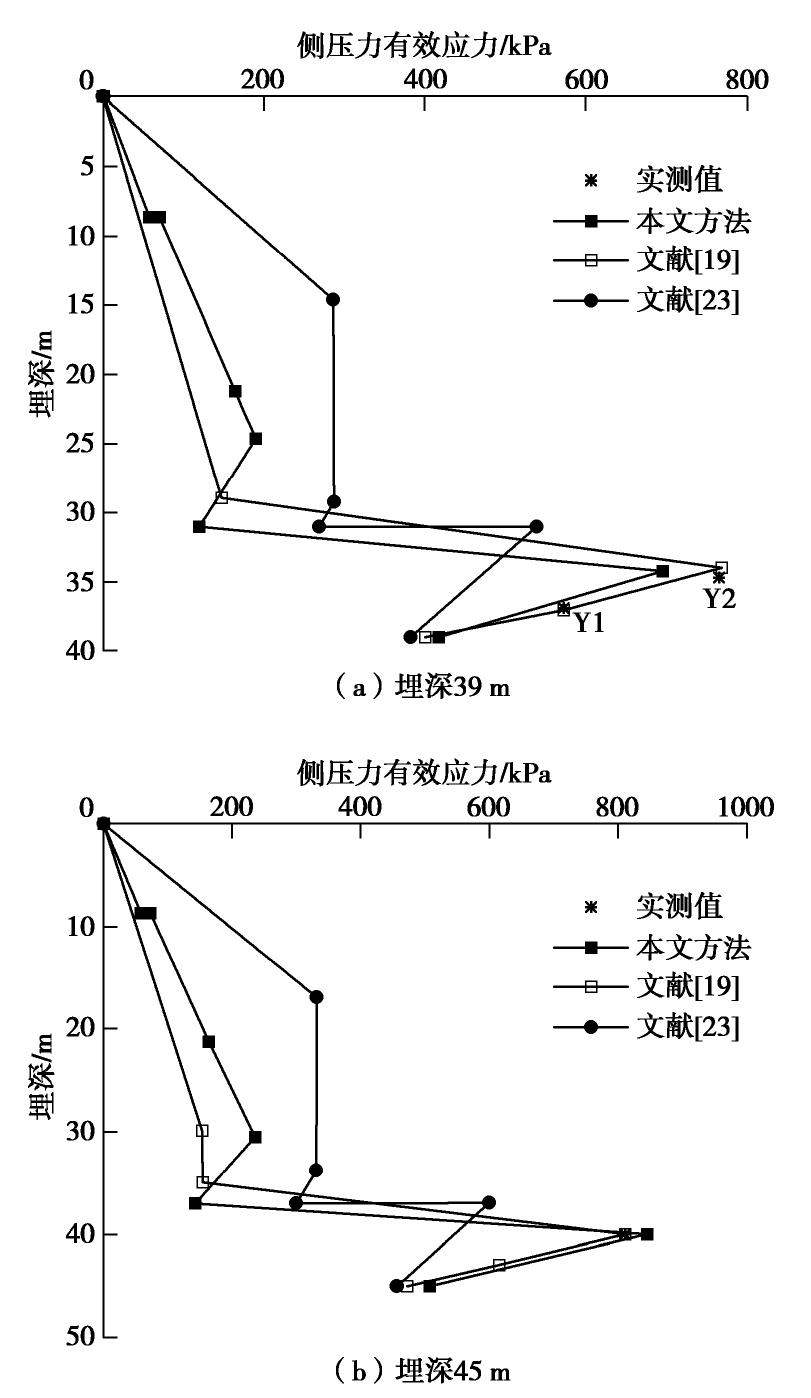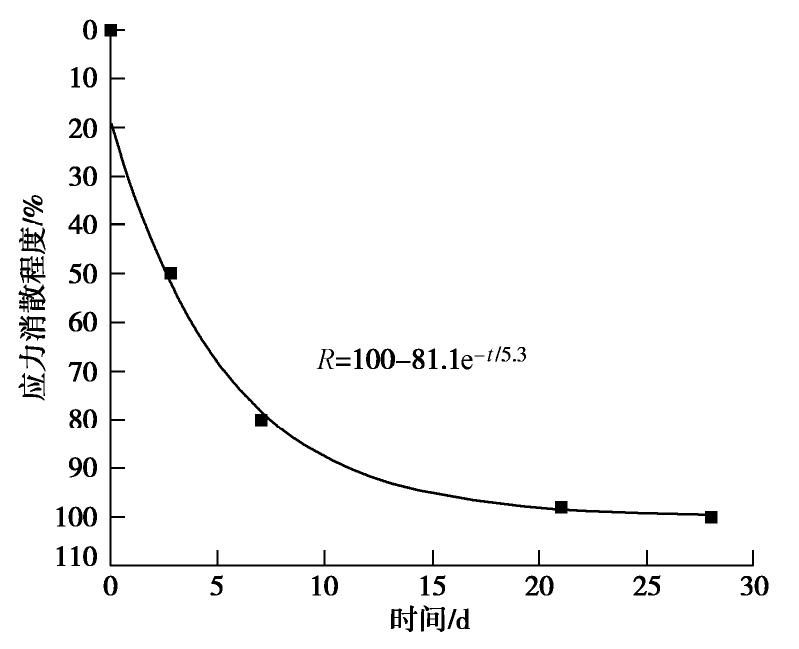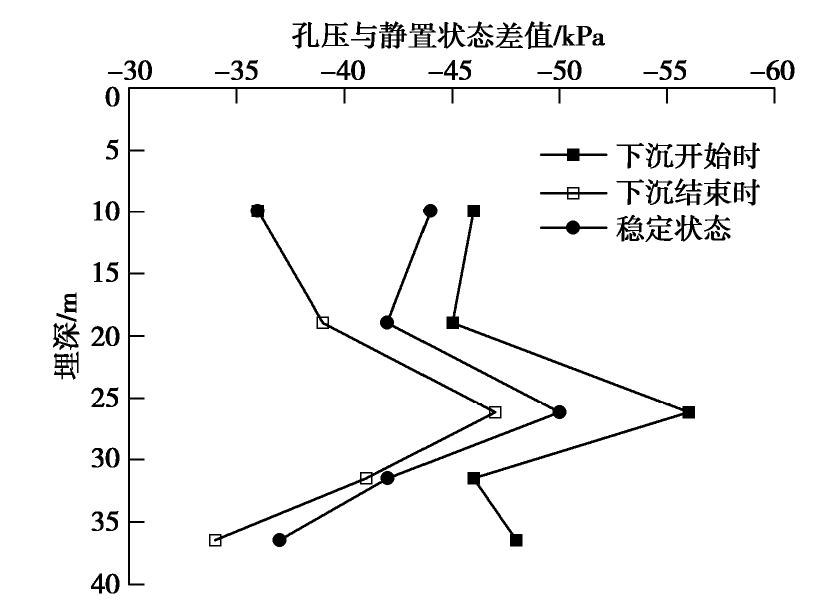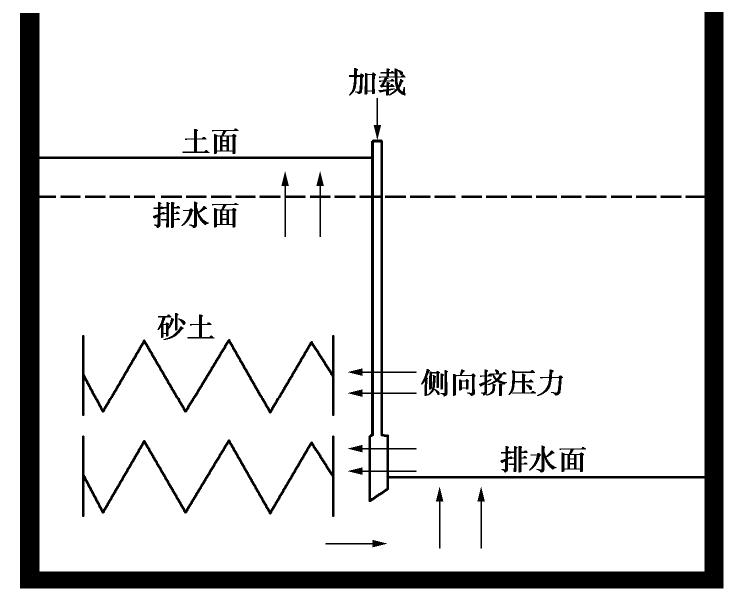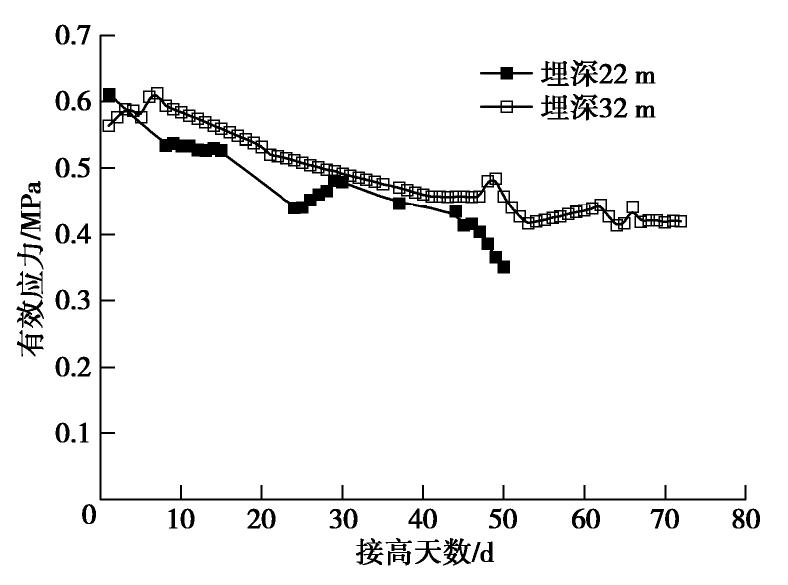Centrifugal model tests on sinking and seepage of a large deep-water open caisson
-
摘要: 以世界最大深水沉井基础为原型,通过离心机再现原型应力场,模拟沉井在埋深超过30 m后的下沉过程和吸泥引起的渗流场,结合原型沉井实测数据对比分析沉井下沉期间的受力,发现超大型深水沉井侧压力分布主要特点为在台阶处较小,刃脚附近存在应力松弛,台阶上下区段均存在应力集中且台阶以下更明显。沉井下沉时侧阻大于接高时,并根据侧压力分布特性给出了沉井竖直状态下侧阻的计算方法。结合渗流数据,分析得出吸泥会使侧壁下部土体变得松散,侧压力大幅减小并与渗透力负相关。当沉井受力平衡时,渗流作用对侧阻平均值的变化影响较小,但对侧阻的分布形式影响较大,并可能打破沉井的受力平衡状态引起翻砂突沉。沉井下沉时对侧壁土体的挤压会引起部分土体应力集中和超静孔压的上升;下沉结束后,部分超静孔压沿排水路径迅速消散,侧壁土体整体上发生竖向固结,由下沉引起的部分挤土应力集中会缓慢消散。Abstract: Based on a largest deep-water open caisson, the centrifuge model tests simulate the seepage field caused by mud suction during sinking when the caisson is buried more than 35 m deep. By comparing and analyzing the forces with the measured data from the prototype caisson, the main characteristics are as follows: the distribution of the lateral pressure is small at the step, the stress relaxes near the blade foot, and it concentrates in the upper and lower sections of the step, while it is more obvious below the step. When the lateral resistance during sinking is greater than the heightening, according to the distribution characteristics of lateral pressure, the method for calculating the side resistance in the vertical state of the caisson is given. The analysis also shows that the seepage effect caused by the mud suction will make the soil at the lower section of side wall become loose, and the lateral pressure is greatly reduced and negatively correlated with the seepage force. And may break the stress balance of the caisson and cause gushing sand and sudden sinking. When sinking, the extrusion of side wall will cause stress concentration and the increase of the excess pore water pressure. After sinking, the excess pore water pressure will dissipate rapidly along the drainage path, and vertical consolidation of soil on the sidewall occurs, and part of the stress concentration of soil caused by subsidence will slowly dissipate.
-
Keywords:
- open caisson /
- centrifugal model test /
- seepage /
- lateral pressure
-
0. 引言
西安地裂缝是20世纪50年代后期发现的,引起了人们的关注。1976年唐山地震后,西安地裂缝显著活动引起建筑物不均匀沉降而破坏。地质、工程界的研究,明确了西安地裂缝是地质构造运动而产生的认识[1-2]。20世纪80年代以来,进一步开展了西安地裂缝的原因、分布及活动规律的调查、监测研究,初步确定了其成因受南侧临潼-长安大断裂控制[2-5]。近年来,西安地裂缝活动加剧不仅受到周围地区地震作用影响,且与西安地区过量开采承压水产生相关。通过对西安地裂缝造成现有建(构)筑物破坏特征分析,地裂缝致灾机理是地裂缝上盘下沉,从而引起不均匀沉降、拉裂和错动位移,进而导致建筑物、地下洞室裂开和坍塌,路基、管道错动和断裂。同时,地表水沿地裂缝入渗和潜蚀,引起黄土湿陷不均匀沉降变形,对建(构)筑物造成二次破坏。西安地裂缝带来的危害性不仅体现在对于各类建(构)筑物生产建设的直接破坏,还会对工程场地土的性质与工程稳定性产生严重影响。从而严重地限制了建筑场地的使用,影响城市建设的合理布局[6-7, 9-10]。
对于这一特殊地质环境下的地铁隧道,特别是横穿地裂缝的隧道结构,衬砌结构沿纵向将承受比正常情况下大得多的附加应力和变形。附加作用表现为:①在地裂缝附近,上盘地层错动下沉可能脱空衬砌结构仰拱基底,或减小基底对衬砌结构的支撑作用,导致隧道衬砌发生剪切破坏;②地裂缝下盘对衬砌结构的约束作用,导致地裂缝附近衬砌结构承受拉应力;③上盘土体向下运动,引起该侧隧道结构变形,相当于弹性地基梁一端发生沉降的弯曲变形;④衬砌结构受地裂缝两侧土体的相运动,对隧道衬砌施加向下的作用力,引起隧道结构出现拉裂变形[6, 8]。地裂缝隧道设计了衬砌结构位移的预留空间[11]。由此可见,未采取措施的地裂缝隧道可能引起衬砌结构强度破坏和防水失效,不能保证正常运营。
为了揭示地裂缝隧道的力学特征和变形形态,需要分析地裂缝的产状和运动特征,以及地裂缝活动对衬砌结构的作用等。
1. 西安地裂缝分布与运动特征
西安地裂缝包括有显露地裂缝与隐伏地裂缝,是典型的黄土地区地质灾害现象。目前已发现14条地裂缝总延伸长度约103 km,分布在150 km2的黄土梁洼地貌范围内,单条地裂缝出露长度在2~12 km之间。其主要位于渭河断裂以南,临潼—长安断裂以北,向东西两侧(浐河至皂河)延伸。西安地裂缝由主裂缝、次生地裂缝和分枝地裂缝三部分组成,总体走向近似平行于临潼—长安断裂;总体倾向近似与临潼-长安断裂倾向相反,倾角约80°。西安地裂缝延伸长度可达数公里至十数公里,空间上呈不等间距平行排列,其分布范围内的地表由北向南呈逐渐升高的梁-洼地貌景观,如图1,2所示[5]。
地裂缝大都发育在“黄土梁”地貌的南侧陡坡上这一特定地貌构造部位。其垂直位移单向累积,断距随深度的增大而增大。地裂缝发育剖面如图3所示。
2. 西安地铁隧道穿越地裂缝的设计
2.1 地裂缝最大竖向预估位移量
西安地裂缝的发展经历了从发生阶段发展至剧烈活动到成熟阶段,随后缓慢变形直至稳定这一过程。地裂缝的最大位移估算如表1所示。
表 1 西安地裂缝最大垂直预估位移量[8]Table 1. Maximum predicted vertical displacements of ground fissures(mm) 地裂缝编号 A(预估极限值) A×1.5(设计值) 地裂缝编号 A(预估极限值) A×1.5(设计值) f2 200 300 f8 100 150 f3 150 225 f10 150 225 f5 300 450 f11 300 450 f6/f6' 300(200) 450(300) f9/f9' 300(250) 450(375) f7 300 450 f12 100 150 2.2 地裂缝区间隧道结构设计
地铁隧道穿越地裂缝不可避免,应遵从以下原则:以结构措施适应变形为主前提下,在地裂缝处理段需须对结构进行分段预留必要的变形空间适应地裂缝的变形;加强断面结构抵抗变形对结构的破坏;变形缝处在结构发生变形时应当能够保持防水的效果。地裂缝活动主变形区范围根据地裂缝活动引起附近地层的活动变形范围确定为:上盘0~6 m,下盘0~4 m;微变形区上盘6~20 m,下盘4~15 m。上盘变形影响范围大于下盘。隧道衬砌结构为了适应地裂缝活动的变形应在地裂缝处应设置变形缝[6, 8]。如4, 5所示。
3. 地裂缝隧道的数值分析
3.1 地裂缝隧道衬砌结构及地层条件的模型
西安地铁二号线地裂缝区段隧道一般采用马蹄形隧道断面,以正交穿越地裂缝的地铁2号线为分析对象,地裂缝区间隧道采用CRD开挖方法,最大断面净空宽为8.3 m,高为8.45 m;初衬为C25喷射混凝土,厚30 cm;二衬为C30模注钢筋混凝土,厚50 cm。衬砌结构沿纵向每10 m或15 m预设10 cm宽的变形缝,充填密封防渗材料封闭变形缝。以便衬砌结构适应地裂缝上下盘土体相对运动,避免衬砌结构附加拉应力,防止基底出现脱空现象。并且在衬砌结构端部局部加厚以便适应可能出现的应力集中现象。
西安地铁地裂缝隧道通过FLAC-3D有限差分软件建立了计算模型。计算模型隧道埋深为10 m,横断面内水平向宽度为80 m,竖向高度为60 m,轴向长度为200 m。模拟地层埋深0~7.5 m为晚更新世风积黄土,埋深7.5~25.5 m为晚更新世粉质黏土及古土壤层,埋深25.5~30.5 m为中更新世黄土及古土壤层,以及埋深30.5 m以下为中更新世粉质黏土。地裂缝采用库仑摩擦接触面模拟;应力应变关系采用莫尔-库仑屈服条件的弹塑性模型描述;地层及二次衬砌结构采用实体单元模拟;初期衬砌结构采用壳单元模拟。
在地裂缝活动导致自由场地地面不均匀沉降如图6所示条件下,衬砌结构错动位移如图7,8和图9所示。衬砌结构变形缝最大挤压变形为3.6 cm,位于地裂缝处变形缝两侧衬砌拱底;最大张拉变形为5.7 cm,位于上盘内邻近地裂缝衬砌结构变形缝的拱底处。衬砌结构变形缝预留10 cm,满足最大挤压变形的要求。衬砌结构大、小主应力如图10,11所示。大主应力受拉的集中区域主要分布在衬砌结构内侧腰部,最大值为2.02 MPa;小主应力受拉的区域也分布于此。地裂缝两侧衬砌结构内侧腰部受拉,应进行加强处理。隧道衬砌结构采用C30混凝土,其抗压强度为30 MPa,抗拉强度为2.01 MPa,添加钢纤维可满足受拉的强度要求。
4. 地裂缝隧道结构与轨道工程措施
在地裂缝区间段隧道运行100 a后,地裂缝会导致隧道下沉500 mm。为保证隧道具有列车运行的空间,在隧道截面扩构段,二衬结构加大截面厚度及增加配筋,提高纵向分布筋直径及间距的方法抵抗扭转、剪切对结构的影响。地裂缝隧道段的初期支护和内衬之间增设沥青混凝土复合衬砌,在初期支护和二次衬砌之间形成夹层,利用沥青混凝土特有的延展性、流变性,密封衬砌结构变形缝。随着地裂缝活动,沥青混凝土在围岩压力作用下沿侧向产生挤出变形,从围岩压力大的部位向围岩压力小的部位流动,使得围岩压力趋于均匀化。当地裂缝活动导致衬砌结构错动变形时,沥青混凝土易产生流变剪切变形,适应衬砌结构变形缝的变化,可发挥其防渗能力。沥青混凝土变形缝构造与变形模型试验结果如图12,13所示。
5. 结论
(1)西安临潼—长安断裂带是地裂缝产生的构造活动,过量开采承压水产生不均匀沉降是地裂缝发展的附加作用。准确预测地裂缝的位移量,是地裂缝隧道结构设计的重要依据。
(2)西安地铁二号线地裂缝影响段65 m设变形缝,在地裂缝影响范围内,主变形段通常占地裂缝80%~90%的总垂直位移量,是主要的设防区,按10 m进行隧道分段。微变形段垂直位移量仅占10%~20%的总位移量,按10~15 m进行隧道分段。
(3)地裂缝隧道结构应采取衬砌结构适应地裂缝变形的原则。在地裂缝处理段需对结构进行分段,预留必要的变形空间作为变形缝以适应地裂缝的变形。加强变形缝断面的结构,以便满足抵抗变形对结构破坏的要求。
(4)衬砌结构内侧拱腰分布拉应力集中区,需提高衬砌结构混凝土的抗拉强度。采取加筋沥青混凝土复合衬砌及沥青玛蹄脂填充变形缝处理,可改善衬砌结构受力条件,密封衬砌结构变形缝,保持防水的效果。
-
表 1 离心模型与原型的相似关系
Table 1 Similarity relation between centrifugal model and prototype
物理量 相似比 物理量 相似比 长度 1∶n 弹性模量 1∶1 密度 1∶1 黏聚力 1∶1 应力 1∶1 内摩擦角 1∶1 应变 1∶1 抗剪强度 1∶1 位移 1∶n 时间 1∶n2 表 2 土体基本参数
Table 2 Basic parameters of soil
土样类别 土颗粒相对密度 内摩擦角/(°) 黏聚力/kPa 孔隙比 饱和重度/(kN·m-3) 渗透系数/10-4 与井壁摩擦系数 粉砂 2.704 36.2 0 0.731 19.84 6.8 0.472 表 3 原型沉井土层地勘参数表
Table 3 Geophysical parameters of soil of prototype caisson
土层编号 土层类别 内摩擦角ϕ/(°) 孔隙比 侧摩阻力标准值/kPa 层底标高/m 1 细砂 42.1 0.65 15 -34.3 2 粉砂 36.4 0.79 15 -48.8 3 粉砂 36.4 0.73 18 -65.0 4 细砂 37.1 0.69 18 -70.1 5 中砂 36.6 0.49 22 -74.5 6 粗砂 40.8 0.50 22 -81.1 7 细砂 41.0 0.59 20 -93.9 8 粗砂 39.3 0.64 25 -102.3 9 细砂 36.6 0.61 22 -114.0 -
[1] NONVEILLER E. Open caissons for deep foundations[J]. Journal of the Geotechnical and Geoenvironmental Engineering, ASCE, 1987, 113(5): 424-439. doi: 10.1061/(ASCE)0733-9410(1987)113:5(424)
[2] TANIMOTO K, TAKAHASHI S. Design and construction of caisson breakwaters: the Japanese experience[J]. Coastal Engineering, 1994, 22(1/2): 57-77.
[3] 胡中波. 深大沉井基底土层承载特性研究[D]. 成都: 西南交通大学, 2016. HU Zhong-bo. Bearing Characteristics Research of the Soil Below Large-Sized Caisson[D]. Chengdu: Southwest Jiaotong University, 2016. (in Chinese)
[4] 张凤祥. 沉井沉箱设计、施工及实例[M]. 北京: 中国建筑工业出版社, 2010. ZHANG Feng-xiang. Design, Construction and Examples of Caissons and Open Caissons[M]. Beijing: China Architecture and Building Press, 2010. (in Chinese)
[5] LUKE A M, RAUCH A F, OLSON R E, et al. Components of suction caisson capacity measured in axial pullout tests[J]. Ocean Engineering, 2005, 32(7): 878-891. doi: 10.1016/j.oceaneng.2004.10.007
[6] SAMUI P, DAS S, KIM D. Uplift capacity of suction caisson in clay using multivariate adaptive regression spline[J]. Ocean Engineering, 2011, 38(17): 2123-2127.
[7] LIAN J, CHEN F, WANG H. Laboratory tests on soil-skirt interaction and penetration resistance of suction caissons during installation in sand[J]. Ocean Engineering, 2014, 84(3): 1-13.
[8] YEA G G, KIM T H. Vertical cutting edge forces measured during the sinking of pneumatic caisson[J]. Marine Georesources & Geotechnology, 2012, 30(2): 103-121.
[9] CHIOU J S, KO Y Y, HSU S Y, et al. Testing and analysis of a laterally loaded bridge caisson foundation in gravel[J]. Soils & Foundations, 2012, 52(3): 562-573.
[10] GEROLYMOS N, GAZETAS G. Development of winkler model for static and dynamic response of caisson foundations with soil and interface nonlinearities[J]. Soil Dynamics & Earthquake Engineering, 2006, 26(5): 363-376.
[11] ZHONG R, HUANG M S. Winkler model for dynamic response of composite caisson-piles foundations: seismic response[J]. Soil Dynamics and Earthquake Engineering, 2013, 55(13): 182-194.
[12] ZAFEIRAKOS A, GEROLYMOS N, DROSOS V. Incremental dynamic analysis of caisson-pier interaction[J]. Soil Dynamics & Earthquake Engineering, 2013, 48(5): 71-88.
[13] 铁路桥涵地基和基础设计规范:TB 10093—2017[S]. 2017. Code for Design on Subsoil and Foundation of Railway Bridge and Culvert: TB 10093—2017[S]. 2017. (in Chinese)
[14] 建筑地基基础设计规范:GB 50007—2011[S]. 2012. Code for Design of Building Foundation: GB 50007—2011[S]. 2012. (in Chinese)
[15] 给水排水工程钢筋混凝土沉井结构设计规程:CECS 137: 2015[S]. 2015. Specification for Structural Design of Reinforced Concrete Sinking Well of Water Supply and Sewage Engineering: CECS 137: 2015[S]. 2015. (in Chinese)
[16] 陈晓平, 茜平一, 张志勇. 沉井基础下沉阻力分布特征研究[J]. 岩土工程学报, 2005, 27(2): 148-152. https://www.cnki.com.cn/Article/CJFDTOTAL-YTGC200502003.htm CHEN Xiao-ping, QIAN Ping-yi, ZHANG Zhi-yong. Study on penetration resistance distribution characteristic of sunk shaft foundation[J]. Chinese Journal of Geotechnical Engineering, 2005, 27(2): 148-152. (in Chinese) https://www.cnki.com.cn/Article/CJFDTOTAL-YTGC200502003.htm
[17] 穆保岗, 朱建民, 牛亚洲. 南京长江四桥北锚碇沉井监控方案及成果分析[J]. 岩土工程学报, 2011, 33(2): 269-274. https://www.cnki.com.cn/Article/CJFDTOTAL-YTGC201102019.htm MU Bao-gang, ZHU Jian-min, NIU Ya-zhou. Monitoring and analysis of north anchorage caisson of Fourth Nanjing Yangtze River Bridge[J]. Chinese Journal of Geotechnical Engineering, 2011, 33(2): 269-274. (in Chinese) https://www.cnki.com.cn/Article/CJFDTOTAL-YTGC201102019.htm
[18] 朱建民, 龚维明, 穆保岗, 等. 南京长江四桥北锚碇沉井下沉安全监控研究[J]. 建筑结构学报, 2010, 31(8): 112-117. https://www.cnki.com.cn/Article/CJFDTOTAL-JZJB201008017.htm ZHU Jian-min, GONG Wei-ming, MU Bao-gang, et al. Sinking safety monitoring research on north anchorage caisson of the Forth Nanjing Yangtze River Bridge[J]. Journal of Building Structures, 2010, 31(8): 112-117. (in Chinese) https://www.cnki.com.cn/Article/CJFDTOTAL-JZJB201008017.htm
[19] 蒋炳楠, 马建林, 褚晶磊, 等. 水中超深大沉井施工期间侧压力现场监测研究[J]. 岩土力学, 2019, 40(4): 1551-1560. https://www.cnki.com.cn/Article/CJFDTOTAL-YTLX201904038.htm JIANG Bing-nan, MA Jian-lin, CHU Jing-lei, et al. On-site monitoring of lateral pressure of ultra-deep large and subaqueous open caisson during construction[J]. Rock and Soil Mechanics, 2019, 40(4): 1551-1560. (in Chinese) https://www.cnki.com.cn/Article/CJFDTOTAL-YTLX201904038.htm
[20] 王建, 刘杨, 张煜. 沉井侧壁摩阻力室内试验研究[J]. 岩土力学, 2013, 34(3): 659-666. https://www.cnki.com.cn/Article/CJFDTOTAL-YTLX201303008.htm WANG Jian, LIU Yang, ZHANG Yu. Model test on sidewall friction of open caisson[J]. Rock and Soil Mechanics, 2013, 34(3): 659-666. (in Chinese) https://www.cnki.com.cn/Article/CJFDTOTAL-YTLX201303008.htm
[21] 李伟雄. 基于被动土压力的沉井结构分析[J]. 岩土工程学报, 2005, 27(11): 1341-1345. https://www.cnki.com.cn/Article/CJFDTOTAL-YTGC200511022.htm LI Wei-xiong. Analysis of Structure of passive earth pressure on open caisson[J]. Chinese Jounal of Geotechnical Engineering, 2005, 27(11): 1341-1345. (in Chinese) https://www.cnki.com.cn/Article/CJFDTOTAL-YTGC200511022.htm
[22] 周和祥, 马建林, 张凯, 等. 沉井下沉阻力离心模型试验研究[J]. 岩土力学, 2019, 40(10): 3969-3976. https://www.cnki.com.cn/Article/CJFDTOTAL-YTLX201910032.htm ZHOU He-xiang, MA Jian-lin, ZHANG Kai, et al. Study on sinking resistance of large and deep caisson based on centrifugal model test[J]. Rock and Soil Mechanics, 2019, 40(10): 3969-3976. (in Chinese) https://www.cnki.com.cn/Article/CJFDTOTAL-YTLX201910032.htm
[23] 周和祥, 马建林, 张凯, 等. 沉井侧壁摩阻力分布特性试验研究[J]. 桥梁建设, 2018, 48(5): 27-32. https://www.cnki.com.cn/Article/CJFDTOTAL-QLJS201805006.htm ZHOU He-xiang, MA Jian-lin, ZHANG Kai, et al. Experimental study on the distribution characteristics of friction resistance on sidewall of the caisson[J]. Bridge Construction, 2018, 48(5): 27-32. (in Chinese) https://www.cnki.com.cn/Article/CJFDTOTAL-QLJS201805006.htm
[24] 褚晶磊, 马建林, 蒋炳楠, 等. 水中沉井下沉期侧壁摩阻力分布试验研究[J]. 岩土工程学报, 2019, 41(4): 707-716. https://www.cnki.com.cn/Article/CJFDTOTAL-YTGC201904018.htm CHU Jing-lei, MA Jian-lin, JIANG Bing-nan, et al. Experimental study on side friction distribution of caissons during sinking in water[J]. Chinese Journal of Geotechnical Engineering, 2019, 41(4): 707-716. (in Chinese) https://www.cnki.com.cn/Article/CJFDTOTAL-YTGC201904018.htm
[25] 蒋炳楠, 马建林, 李孟豪, 等. 水中沉井下沉期间刃脚空间受力试验研究[J]. 岩土力学, 2019, 40(5): 1693-1703. https://www.cnki.com.cn/Article/CJFDTOTAL-YTLX201905009.htm JIANG Bing-nan, MA Jian-lin, LI Meng-hao, et al. Experiments on spatial stress of foot blade during caisson sinking in water[J]. Rock and Soil Mechanics, 2019, 40(5): 1693-1703. (in Chinese) https://www.cnki.com.cn/Article/CJFDTOTAL-YTLX201905009.htm
[26] 蒋炳楠. 沪通大桥超深大沉井下沉阻力及突沉现场监测研究[D]. 成都: 西南交通大学, 2016. JIANG Bing-nan. Resistance and Suddenly Sinking Monitor Research of Deep and Large Open Caisson of Hutong Bridge[D]. Chengdu: Southwest Jiaotong University, 2016. (in Chinese)
[27] 徐光明, 章为民. 离心模型中的粒径效应和边界效应研究[J]. 岩土工程学报, 1996, 18(3): 80-86. https://www.cnki.com.cn/Article/CJFDTOTAL-YTGC603.011.htm XU Guang-ming, ZHANG Wei-min. Study on particle size effect and boundary effect in centrifugal model[J]. Chinese Journal of Geotechnical Engineering, 1996, 18(3): 80-86. (in Chinese) https://www.cnki.com.cn/Article/CJFDTOTAL-YTGC603.011.htm
[28] 交通部第一公路总公司. 公路施工手册:桥涵[M]. 北京: 人民交通出版社, 2000. First Highway Corporation of the Ministry of Communications. Highway Construction Manual: Bridge and Culvert[M]. Beijing: China Communications Press, 2000. (in Chinese)
[29] 太沙基. 理论土力学[M]. 徐志英,译.北京: 地质出版社, 1960. -
期刊类型引用(4)
1. 史治文. 西安地铁八号线地裂缝隧道暗挖施工技术与沉降控制措施研究. 结构工程师. 2024(05): 137-142 .  百度学术
百度学术
2. 秦璐. 考虑地裂缝影响的盾构隧道变形破坏机制试验研究. 九江学院学报(自然科学版). 2023(03): 47-51 .  百度学术
百度学术
3. 苗晨阳,黄强兵,苟玉轩,滕宏泉,贾少春. 地裂缝场地盾构隧道下穿施工对既有管廊的影响研究. 现代隧道技术. 2022(03): 155-165+171 .  百度学术
百度学术
4. 赵阳川. 某铁路隧道衬砌裂缝对结构安全的影响分析. 工程建设与设计. 2022(17): 97-101 .  百度学术
百度学术
其他类型引用(2)




 下载:
下载:












